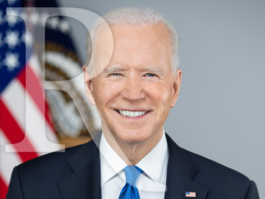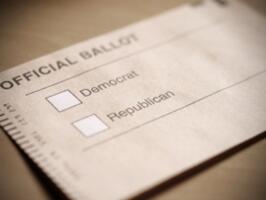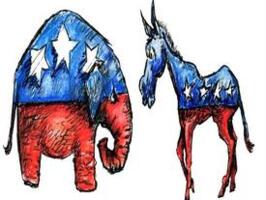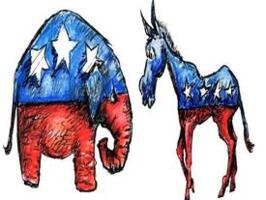50% Consider GOP Congressional Agenda Extreme; 46% Say Same of Democrats
As the federal government shutdown enters its fourth day, voters are slightly more likely to identify with President Obama and congressional Democrats. But a surprising problem for congressional Republicans is that nearly one-out-of-four still thinks they are too liberal.
The latest Rasmussen Reports national telephone survey finds that 33% of Likely U.S. Voters view President Obama in political terms as about the same as they are. Thirty-one percent (31%) say the same of the average Democrat in Congress, but only 23% feel that way about the average congressional Republican. (To see survey question wording, click here.)
Fifty-four percent (54%) think the president is more liberal than they are, while nine percent (9%) feel he is more conservative.
Fifty-six percent (56%) believe the average congressional Democrat is more liberal than they are. Only eight percent (8%) see that congressman as more conservative.
As for the average Republican in Congress, 50% think he or she is more conservative than they are, but a surprising 21% consider that GOP member as more liberal.
Overall perceptions have changed little since October 2011, although voters are now slightly more likely to agree with the president and his party members in Congress.
Fifty percent (50%) of voters view the agenda of Republicans in Congress as extreme, while 46% say the same of the Democratic congressional agenda. Thirty-three percent (33%) identify the GOP agenda as mainstream. Forty-one percent (41%) see the Democratic congressional agenda as mainstream.
This marks a shift from August 2010 just before the mid-term congressional elections in which Republicans regained control of the House and Democrats held their majority in the Senate. At that time, 45% said the GOP agenda was mainstream, while 40% considered it extreme. Thirty-seven percent (37%) believed the Democratic agenda was mainstream; 57% said extreme.
Special offer: A Rasmussen Reader subscription that lasts through December 31, 2014 is now just $24.95. Sign up today!
(Want a free daily e-mail update? If it's in the news, it's in our polls). Rasmussen Reports updates are also available on Twitter or Facebook.
The national survey of 1,000 Likely Voters was conducted on October 2-3, 2013 by Rasmussen Reports. The margin of sampling error is +/- 3 percentage points with a 95% level of confidence. Field work for all Rasmussen Reports surveys is conducted by Pulse Opinion Research, LLC. See methodology.
Forty-two percent (42%) of voters identify themselves as conservative on fiscal issues such as taxes, government spending and business regulation. Just half as many (21%) are liberal in this area, while 34% view themselves as moderates.
Most Democratic voters consider the president and the average Democrat in Congress as about the same as they are in political terms.
Republicans remain much more conflicted about their congressional representatives. Findings suggest that these voters don’t think Republicans in Congress are being conservative enough: Only 34% consider the average Republican in Congress about the same as they are politically, but another 34% think that member is more liberal than they are. Just 27% see that congressman as more conservative than they are.
Most voters not affiliated with either major political party don’t identify with either side. Twenty-nine percent (29%) see the president as about the same as they are politically, while 21% and 25% say the same of the average Republican in Congress and the average Democrat in Congress respectively.
Fifty-three percent (53%) of unaffiliated voters consider the agenda of Democrats in Congress to be extreme. A plurality (45%) also believes the Republican congressional agenda is extreme.
Just 56% of Republican voters view the GOP congressional agenda as mainstream, compared to 71% of Democrats who feel that way about the agenda of their party in Congress.
Seventy percent (70%) of all voters consider the president at least somewhat liberal in political terms, including 44% who believe he is Very Liberal.
Sixty-five percent (65%) of Republican voters think Republicans in Congress have lost touch with GOP voters from throughout the nation over the last several years. Fifty-nine percent (59%) of Democrats, on the other hand, believe Democrats in Congress have done a good job of representing their party's values.
Additional information from this survey and a full demographic breakdown are available to Platinum Members only.
Please sign up for the Rasmussen Reports daily e-mail update (it’s free) or follow us on Twitter or Facebook. Let us keep you up to date with the latest public opinion news.
The national survey of 1,000 Likely Voters was conducted on October 2-3, 2013 by Rasmussen Reports. The margin of sampling error is +/- 3 percentage points with a 95% level of confidence. Field work for all Rasmussen Reports surveys is conducted by Pulse Opinion Research, LLC. See methodology.
Rasmussen Reports is a media company specializing in the collection, publication and distribution of public opinion information.
We conduct public opinion polls on a variety of topics to inform our audience on events in the news and other topics of interest. To ensure editorial control and independence, we pay for the polls ourselves and generate revenue through the sale of subscriptions, sponsorships, and advertising. Nightly polling on politics, business and lifestyle topics provides the content to update the Rasmussen Reports web site many times each day. If it's in the news, it's in our polls. Additionally, the data drives a daily update newsletter and various media outlets across the country.
Some information, including the Rasmussen Reports daily Presidential Tracking Poll and commentaries are available for free to the general public. Subscriptions are available for $4.95 a month or 34.95 a year that provide subscribers with exclusive access to more than 20 stories per week on upcoming elections, consumer confidence, and issues that affect us all. For those who are really into the numbers, Platinum Members can review demographic crosstabs and a full history of our data.
To learn more about our methodology, click here.





